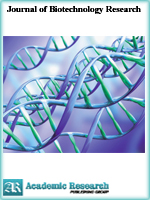Journal of Biotechnology Research
Online ISSN: 2413-3256
Print ISSN: 2413-8878
Print ISSN: 2413-8878
Quarterly Published (4 Issues Per Year)

Archives
Volume 5 Number 11 November 2019
Regulatory and Metabolic Interactions of Carbohydrates and Lipids in Diabetes and Obesity
Authors: Dr. Chrysanthus Chukwuma Sr
Pages: 123-127
DOI: doi.org/10.32861/jbr.511.123.127
Abstract
This paper attempts to review available pertinent scientific and medical literature that the current global epidemic of obesity and diabetes has increased simultaneously or contemporaneously with adverse metabolic events. There is widespread established evidence that the type of carbohydrate consumed is important in the development or prevention of insulin resistance, obesity, and the metabolic syndrome. There is scarcity of published data on the combined effects of interactions between micronutrients, carbohydrates and lipids. However, there are extensive data supporting the benefits of the effects of both carbohydrates and lipids on various mechanisms of energy balance and diseases. Adequate measure is necessary to control carbohydrate-lipid interactions as they impact on obesity and diabetes.
Marine Pollution of Chemicals Detergents Contamination Induced Apoptosis and Necrosis in Fish Liver (Sardine aurita) by Flow Cytometry DNA Measurements
Authors: Tito N. Habib ; Mohamed F. El-Sayed ; Fathi M. Ali ; Tawfiq M. Almsatar
Pages: 113-122
DOI: doi.org/10.32861/jbr.511.113.122
Abstract
Background: Presently, there are wide uses of detergents, which discharged to marine environment (Mediterrean sea). Detergents are organic chemical compounds, consisting of fatty acids, and different components of Alkyl Benzene, Sulphonates, Polyphosphates, Cellulose, Sucrinic acid, and Sodium Lauryl Sulfates. Further, even if at low concentrations, the synthetic detergents are considered to be toxic to marine biodiversity. Since, these surfactants are not completely degraded by waste water treatment. It has ability to damage the DNA and accumulated on fish and other marine organisms. Methods: Flow cytometry technique was applied, because it’s accuracy for analysis of DNA contents. Hence, the present study evaluated the impact of sodium lauryl sulfate as synthetic detergent on the DNA of sardine fish as a marine biological indicator. Sardinella aurita was collected from clean and SLS-contaminated sites. The flow cytometry technique was employed to assess levels of active (apoptosis) and passive (necrosis) cell death in both exposed and unexposed fishes to SLS. Result: Chemical detergent contains 120 ml (i.e., 20mg/L) of sodium lauryl sulfates. The result shows more distinct and significant differences of the early and late apoptosis/ necrosis of Sardine fish liver, compared with unexposed fish samples from cleaned reference site. Conclusions: The present data indicate that SLS was able to cause toxicity to fish. Data recorded revealed that toxicity as a significant accumulation of hepatic tissue cellular DNA during the G0-G1 in a significant way (P<0.05), compared with that of unexposed liver tissue. In the same way, there was an insignificant accumulation of hepatic cell’s DNA in the S phase but not during the G2/M phase, finally there was a significant arrest / DNA accumulation during the PreG1- phase (P<0.05). In the meantime, accompanies of apoptotic profile of cells exposed to SLS showed a significant total apoptotic form significantly elevated compared with reference site.
Productive Performance and Blood Profile of Weaner Rabbit Fed Different Inclusion Levels of Ipomoea asarifolia Leaf Meal in Replacement of Soybean Meal
Authors: Shittu M. D. ; Adesina G. O. ; Eseigbe S.
Pages: 107-112
DOI: doi.org/10.32861/jbr.511.107.112
Abstract
In an experiment to determine the effect of feeding graded levels of Ipomoea asarifolia Leaf Meal (IALM) on the growth, heamatology and serum chemistry of rabbits in the tropics, twenty-four (24) weaned male rabbits, 6-8 weeks old, were randomly allotted to four (4) dietary treatments in which IALM was used to replaced soybean meal (SBM) at 0% (control), 10%, 20%, and 30% with six (6) rabbits per treatment in a completely randomized design experiment. Each rabbit constituted a replicate. Feed and water were offer ad libitum while other standard management practices were meticulously observed. The Proximate analysis of the diets and leaf was determined according to the AOAC [1] for crude protein, crude fibre, ether extract (fat) and ash while haematological analysis was done using Sysmex KX-21N automated analyzer and while serum parameters were analyzed following standard procedure. The data obtained were subjected to one-way analysis of variance in a completely randomized design experiment. The IALM had average crude fibre percentage of 7.15%, while crude protein, ash, ether extract and metabolisable energy were 28.40%, 11.00%, 7.10%, 3236.15 KcalKg) respectively. All growth parameters were affected by IALM except weight gained and FCR. Haematological and serological parameters measured at the end of 8 weeks of feeding indicated significant (P<0.05) variations in, mean cell haemoglobin (MCH) and alkaline phosphatase, cholesterol, globulin, platelet, white blood cell count (WBC) and total serum proteins with variations in the level of dietary IALM. The aspartate amino acid, alanine amino acid, red blood cell count, mean cell volume (MCV), and intermediate cell count were, however, unaffected (P>0.05) by variations in the level of dietary IALM.



